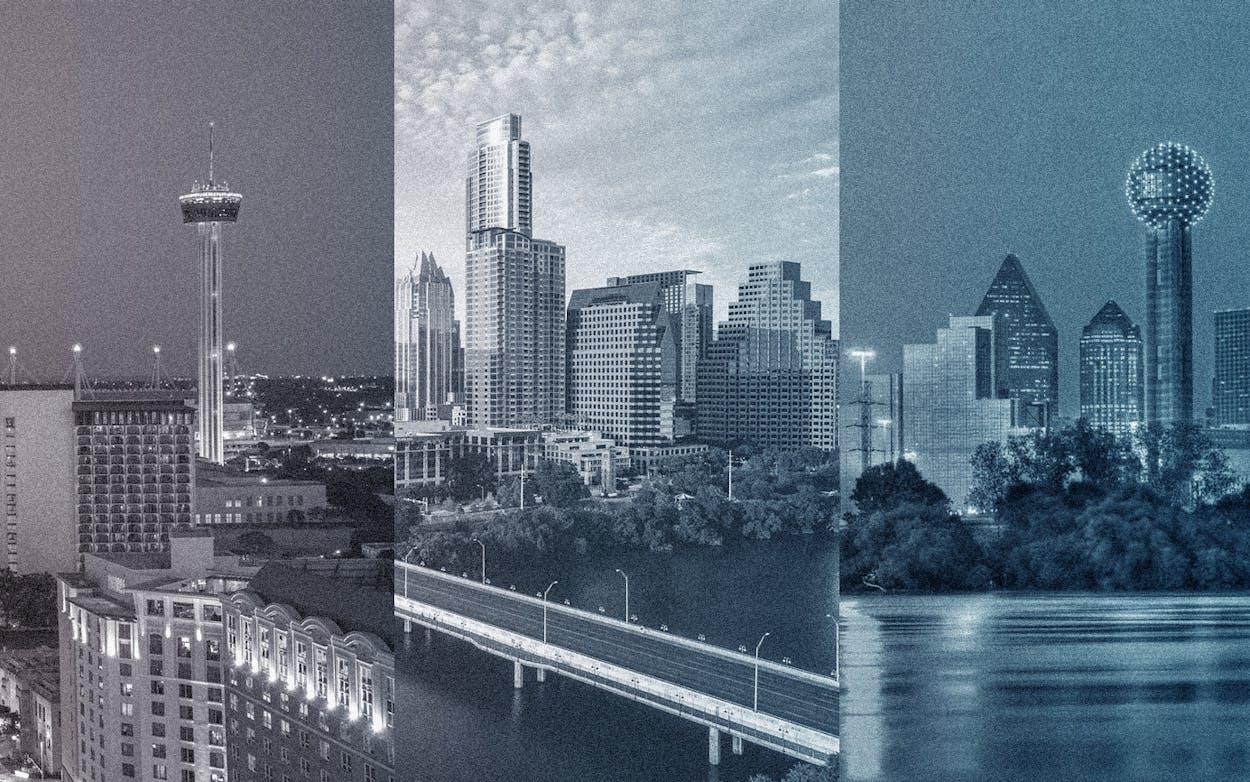It’s not news that Texas suburbs are booming. Frisco, McKinney, Conroe, Pearland, New Braunfels, League City, Round Rock, and Denton were among the 25 fastest-growing cities in America since 2010 (as was Austin proper, as well as Midland and Odessa). But a statistic like that doesn’t tell the full story of growth in Texas—or how so many newly minted Texans are shaping the state’s future.
To get a better sense of where things are likely headed, let’s take a look at something reported by the Houston Chronicle last week: that more of these new Texans have registered to vote along the Interstate 35 corridor than in the rest of the state combined. Of the ten counties that added the most voters, at least seven of them run firmly along I-35. (If you count Rockwall County, about thirty miles east of the interstate in Dallas, and Parker County, the same distance in the other direction from Fort Worth, you’ll get to nine out of ten.) And as the I-35 corridor grows in political influence, the Chronicle notes, voter registration numbers in East Texas and the Panhandle have dropped. Even the fast-growing suburbs of Houston haven’t seen booms in voter registrations by 20 percent or more, the way the counties surrounding San Antonio, Austin, and Dallas have.
Texas Democrats are excited about the political balance of power shifting to the I-35 corridor. They envision a “blue spine” that would help them, eventually, carry statewide races. In late January, the Texas Democratic Party announced a list of 22 House seats in the Legislature that it intends to target, and 12 of them hug the interstate. Given that the majority of seats in San Antonio and Austin are already blue—and the Dallas–Fort Worth area is split roughly 50/50—the Democratic party’s path to taking over the House definitely travels along I-35. There are more than twice as many seats in the DFW area as there are along the entire border, from El Paso to South Padre Island, and the stretch from San Antonio to Austin represents almost as many as the greater Houston area. And crucially, those suburban voters are generally less conservative than the state as a whole.
Nowhere in Texas has grown faster than the stretch of the state that runs along I-35 from San Antonio to the suburbs north of Austin. The cities and towns to the north of San Antonio have enjoyed their own identities—New Braunfels and San Marcos barely qualify as suburbs of San Antonio and Austin, respectively—but as the cities around them have grown, the entire stretch has ballooned into what’s effectively becoming a single metro area.
And that growth is feeding an explosion in voter registrations. Leading the pack is Hays County, with a 31 percent spike in voter registrations since 2016. House District 45, which covers Hays and Blanco counties, was a significant red-to-blue hot spot in the 2018 election. After nearly a decade as a red district, a young Democrat, 33-year-old Erin Zwiener, won a narrowly contested race against a GOP rival in an election that saw more than 83,000 votes—20,000 more than voted in the county in even a presidential year. According to Brandon Rottinghaus, a University of Houston political science professor interviewed by the Chronicle, growth in a place like Hays County changes everything about how Democrats campaign in Texas. “The problem Democrats had for the longest time was that they didn’t have enough people to even talk to,” he told the paper.
Not only are there more people to talk to, there are people from different backgrounds to talk to, as well. Democrats have infamously not won a statewide election in a quarter-century, but they can count on the fact that growing suburbs are diversifying suburbs. In September, the Dallas Morning News quoted Nancy Bocskor, director of the Center for Women in Politics & Public Policy at Texas Woman’s University in Denton, on what all the growth means for Denton’s demographics. “I’ve never seen more housing construction, road construction, business construction than I’ve seen between Denton and Dallas. When you have that kind of rapid growth you have new kinds of people,” she told the paper.
That tracks with Denton County’s demographics, too: In 2010, 64 percent of Denton residents identified as “white alone,” while 2019 estimates from the Census Bureau put that figure at 58 percent. Over that same decade, Denton County went from a +32 district for the GOP in the 2012 presidential election to a +20 district in 2016, and a +8 district in the 2018 senate race between Ted Cruz and Beto O’Rourke.
There’s no guarantee that more voters along the I-35 corridor automatically means better results for Democrats, of course. Outside of the urban and suburban areas in the major cities, the I-35 corridor isn’t booming in the same way, but voter registrations are still increasing faster than the overall population. Waco has seen annual growth of around 1 percent since the last U.S. census, and added roughly 4,000 new residents since 2016—but in that same time, the county registered more than 15,000 new voters, a 12 percent increase from the last election. (In rural Hill and Falls counties, which also fall between Austin and Dallas along the highway, the growth in voter registration came in at 2 percent.) In these parts of the state—at least at the moment—GOP candidates still do quite well at the polls, and Republican super PACs are focused on recruiting new voters, too.
But if Hays County represents the future, Texas Democrats will have a road map they can follow all the way from Oklahoma to Laredo. That would be enough for them to swing the statehouse—and maybe even more, further on down the road.
- More About:
- Politics & Policy
- Texas Legislature








